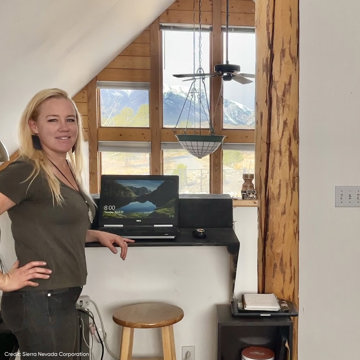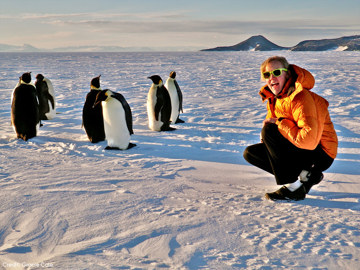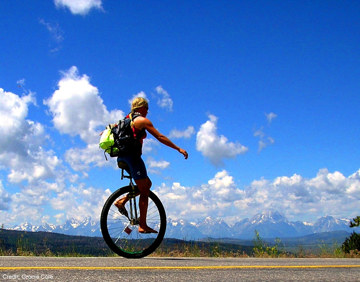Employee Spotlight: Meet Dream Chaser Systems Engineer, Gracie C.
May 06, 2021
Everyone’s path to their careers is different. And you certainly don’t need to study space, or even engineering, for that matter, to end up working in the aerospace field.
So, when SNC systems engineer Gracie C. sent over a presentation she planned on giving to a college class highlighting the music degree she earned at Duke University, not one, but two cross country unicycle trips, and time spent in the United States Antarctic Program, needless to say, interests were piqued.
Reading over the presentation, the song lyric, ‘you may ask yourself, well, how did I get here?’ from the Talking Heads song, Once in a Lifetime, kept playing in this author’s mind. So, I sent over a list of questions, mainly to learn about the whole unicycling thing, but also to learn just how Gracie C. landed at SNC.
Let’s start with your college career. You majored in music at Duke University. What instrument did you play?
I have played piano since I was six years old, but over the years dabbled in a range of other instruments. While at Duke, I played clarinet in the Wind Symphony and took a classical performance piano course. Nowadays, piano is my diversion, drums are on deck and I can occasionally be caught embarrassing my friends in public with barely-recognizable songs on the bagpipes. But I didn’t always hurt people’s ears on the bagpipes – the highlight of my musical career was performing with Hell’s Belles (world-famous, all-female AC/DC tribute band) at The Oriental in Denver.
You went onto get a degree in engineering from Colorado School of Mines. How did that transition happen?
I chose Duke University because it was the best fit for me academically and athletically, as I was intent on getting my Mechanical Engineering degree and committed to the field hockey team. While I spent my first few semesters double-majoring in mechanical engineering and music, some extremely difficult life situations collided with my plan, and I ended up dropping the mechanical engineering degree and kept the music degree in order to tend to my overall wellbeing.
However, I was still wired to be an engineer (thankfully music is very mathematical!), so it sat on the back burner for a while. After years of adventures, I ended up working in Antarctica, where all that work on the ice really turned up the heat on that back burner, so I seized the day, went back to school and finally got that engineering degree. Thankfully, Colorado School of Mines is right in our collective backyard, so it was an obvious choice. What can I say, some people take a gap year, some people take a gap decade!
Antarctica! Not many people can cross that continent off their list! You participated in the United States Antarctic Program- how did you get involved? Were you using your engineering degree while there?
The first day of ninth grade geography class, my teacher showed us pictures from around the world to provide context for the curriculum. I didn’t know it at the time, but when a penguin with an icy white background popped up on the projector screen, it launched a pinball into my machine of life. It took a lot of bouncing off bumpers and desperate flipper activation to find my way to the bottom of the earth. Washing dishes in the galley was my very first job on the ice and from there I tried out several jobs over the course of many seasons, including as communications operator for science parties in remote field camps. Finally, I landed a job as a fuels operator, fueling aircrafts, setting up fuel systems, and moving fuel to keep buildings, field camps and the South Pole Station warm and safe. As a fuels operator, I was constantly using mechanical engineering concepts to do things like set up fluid transport systems and troubleshooting diesel pumps at -60˚F in the noonday darkness. I was so passionate about this work that I could no longer dismiss that yearning on the back burner for an engineering degree and career.
 How long were you in Antarctica? What was your favorite part?
How long were you in Antarctica? What was your favorite part?
Overall, I spent eight seasons on the ice over the course of seven years, including three long Antarctic winters with no sunlight for months on end. I ended up meeting my husband down there; he worked there for 11 seasons.
It’s hard to choose the best parts of the Antarctic experience, between performing in a hip hop dance crew and poking my head into the famous Antarctic explorer Ernest Shackleton’s old bunk bed with the smell of a penguin rookery filling my nose, or between finding a way to use trash to construct makeshift Kiss costumes and jumping into 27˚F sea water in midwinter darkness with -37˚F air waiting to freeze my drenched tutu.
However, the most special moment was helping to close up a remote field camp for the season and having the opportunity to hook a sling load by hand to the belly of a helicopter as it hovered just over my head, rotors pounding, blinding me with a storm of volcanic dust. That moment was extra special because the helicopter was the same type my dad flew in Vietnam.
Onto the next adventure! In the presentation you shared in a presentation to college students, there are pictures of you unicycling. What inspired you to take up the sport?
When I was about 12 years old, a catalog of useless things came in the mail. As I flipped through it, I saw a kid on a unicycle and—even before I knew what a party trick was—thought, “Wow, I want to know how to do that!” I begged and begged for it for Christmas and was ecstatic when my parents actually got it for me. My older brother was so embarrassed with my antics that he made my parents promise to restrict me from riding outside the neighborhood. Well, that promise didn’t go so well.
You’re the first woman to ride a unicycle across the country- how did this journey come about? 
As I was finishing up my degree at Duke, I had been dreaming up an insane post-graduation adventure. I grew up in Davis, California, which was once named the best small town for cycling in the United States, so biking was a native language for me. I was one of those people who felt the pull to ride my bike across the country, but as I was unicycling to class one day (yes, I was that person on campus), I wondered if anyone had ever ridden a unicycle across the U.S. It turned out that maybe 10 or so men had, but no woman. To this day, I am the only known woman to have ridden a unicycle across the country.
You did it barefoot- why?
Riding barefoot was an entirely practical decision. As a California-grown kid, I was always barefoot; riding a unicycle with shoes scared me because I couldn’t feel the pedals as well. On a unicycle, constant pedal pressure is a key to staying upright, so having direct pedal contact made me feel safer.
You also rode the Great Divide Mountain Bike Route- which trip was more difficult?
The coast-to-coast journey was more difficult for me; not only was it a much longer distance (3,600 vs. 2,700 miles), it was my first trip of that nature and I had a lot of new mental and physical challenges to face. Overcoming the challenges on the first trip made me well prepared to become the first person to unicycle the world’s longest off-pavement cycling route. But, let’s be honest about two things: 1) there are really good reasons more people don’t “unicycle tour,” and 2) apparently, I do not like to learn lessons the easy way.
You raised money to fight blood cancers during your journeys. How much money did you raise and is there a personal connection to that cause?
Both of the unicycle trips were propelled by my desire to raise awareness and funds for the Leukemia & Lymphoma Society (LLS), to help people battling blood cancers. At the time of my first long unicycle ride, a very dear uncle of mine was undergoing his most intense treatments for multiple myeloma. Together, the trips raised $20,000 for the LLS, and the unicycles are now housed in the National Bike Museum (free storage!). A couple years after the second trip, my uncle lost his battle with cancer, but I am grateful for the amazing relationship I had with him and the opportunity to become more aware of the struggles many people face and the health I so often take for granted.
You’ve also roller skated across the country too- which trip did you enjoy more?
Roller skating was much more enjoyable physically, and the fundraising cause was similarly close to my heart. Skating to support survivors of domestic violence and sexual abuse, leading a group of women from my roller derby team, and connecting with derby teams and advocacy groups along the way across the U.S. were all life-changing facets that propelled this trip and made it the most enjoyable cross-country trek of the three. I’m not asking for more Forrest Gump jokes, but when I got to the Santa Monica pier in California, I honestly wanted to keep skating, at least in an earn-my-ice cream sort of way.
Any other extreme cross country journeys planned?
No, thank you! But I would do just about anything to get to space!
How long have you worked at SNC?
My first role was as an intern with SNC’s ISR, Aviation & Security business area. My first-ever engineering internship involved working on a project for C-130 planes, which is a primary type of aircraft I fueled in Antarctica; it was magically full circle! I really enjoyed it, and was also eager to work on the Dream Chaser® spaceplane program. When I was given the opportunity to transfer over to SNC’s space operations, it ended up being a perfect fit for me. I’ve had the chance to work and learn with the thermal analysis and cargo integration teams before converting to fulltime with the flight software team.
You’re a systems engineer on the Dream Chaser team- what’s a day in the life like?
I am learning SO much! Every day, I am learning new ways to perform my job more effectively and efficiently, and trying to get up to speed with the nuanced bodies of knowledge that comprise the flight software tools. My current efforts as a systems engineer on the tools team are to make it as easy as possible for subsystem experts to update the data and parameters that the spacecraft will need to guide the function of both mechanical components and electrical sensors. At a practical level, “a day in the life” involves a lot of coding, communication and data organization, all of which I love!
What’s your favorite part about working on the Dream Chaser team?
Massive undertakings make me tick. Excessive difficulty lures me. Opportunities to achieve that which feels impossible compels me.
The Dream Chaser team experience so far has been wildly supportive, constantly engaging and enticingly challenging. I’m so grateful to be on a team where people are always willing to help me learn and share camaraderie through the tougher times!
If you could go to space with anyone, dead or alive, who would it be and why?
Are you there Ann Bancroft? It’s me, Gracie. Ann is the first woman to trek to both the North and South Poles. She is kind, humble, and well out of my league—which means I could learn SO much from her presence and being alongside her as we faced the physical, mental and emotional challenges of new and extreme scenarios.
What’s your favorite thing to do when you’re not at work?
Outside of work, I spend a lot of time trail running, sewing custom clothes and gear, tinkering on my now-electric 1979 Volkswagen Bus and roughhousing with my pack of Alaskan Malamutes. I also spend way too much time planning ridiculous shenanigans with my husband and watching Real Housewives.
---
Interested in joining the Sierra Nevada Corporation team? Apply today at sncorp.com/careers.